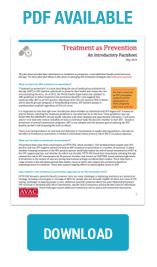- About UsOur Story, Our Team & Support Information
- What We DoAdvocacy to Achieve the End of AIDS
- Advance HIV/SRH Integration
- Advocate for Access to High-Impact Prevention
- Improve Research Conduct
- Product Innovation & Availability
- Promote Effective HIV Prevention Policy
- Strengthen Global Advocacy Networks
- Track and Translate the Field
- Our FocusInterventions to End the Epidemic
- ResourcesPublications, Infographics, Events & More
- MediaInformation & Resources for the Press
- Our BlogPrevention News & Perspective
What is the role of antiretroviral treatment (ART) in the epidemic response today?
Scale up of antiretroviral treatment for people living with HIV is the cornerstone of the UNAIDS “Fast-Track” strategy for ending the epidemic by 2020. This strategy calls for 90 percent of people living with HIV to know their status, 90 percent of those people to be on ART, and 90 percent of those people to be virologically suppressed (meaning that the drugs are working so well that there is no replication in the blood). This “90-90-90” strategy is complemented by WHO guidelines that recommend people who test HIV positive are immediately offered ART, regardless of CD4 cell count.
These recommendations are based on data that shows that ART for the HIV-positive partner in a sexual relationship significantly reduced the chances of onward transmission. ART reduces women’s risk of transmitting HIV during pregnancy, labor and breastfeeding. In addition to this prevention benefit, there is strong evidence of a clinical benefit to an individual taking ART regardless of CD4 cell count. No similar evidence suggests needle-sharing partners are less likely to transmit HIV is their viral load is suppressed.
How are ART programs changing?
The emphasis on using ART for both individual and clinical benefit has prompted a range of shifts at the country and global level. Every context is different; however large trends are underway and advocates need to track and influence them.
Changing initiation criteria and/or service delivery models:
Today’s “test and offer” approach moves programs away from—and may eventually eliminate—use of CD4 cell counts or physician assessment of illness as the trigger to initiate ART. This means changing messages and service delivery models in order to offer ART, and to support informed choices, for individuals as soon as they are diagnosed. The service delivery model needs to include support services, counseling messages and adherence support that may be different from approaches built around earlier notions that ART was for people who were sick. It is critical for advocates to track, inform and implement effective models. Advocates play a critical role when it comes to expanding access to ART via programs that support individual choices about when to start ART and include effective, community-led service delivery.
- Increasing emphasis on virologic monitoring: ART has the greatest clinical and prevention benefit when an individual living with HIV is virologically suppressed. Yet viral load machines to measure this suppression are scarce in sub-Saharan Africa, where the emphasis has been on CD4 cell count monitoring. This is beginning to change. Shifting the monitoring tools and strategies is costly; the concept of virologic suppression is also new in some contexts and communities where CD4 cell count may be well understood. Advocates need to track both investments, access and community understanding of and demand for viral load as part of ART services.
- Increasing investments on ART to meet new coverage goals: The public health benefit of ART depends on high coverage of effective ART among people living with HIV. Countries are shifting their goals based on epidemiological data about the coverage needed to impact the epidemic. The GFATM and PEPFAR are also emphasizing high coverage of ART as a key component to high-impact programming. These coverage goals are valuable and reaching them can have a profound positive impact on the epidemic, providing that people who start ART remain on it, are able to take it correctly and consistently, and face minimal obstacles in accessing medications, laboratory analyses and supportive care. However, in the context of limited resources, it is critical for advocates to track investments in other core prevention strategies, including VMMC and PrEP to be sure that there are sufficient resources in all the elements of combination prevention.
What are the data on ART and HIV prevention?
The primary data come from a trial known as HPTN 052, which enrolled 1,763 serodiscordant couples (one HIV-positive and one HIV-negative partner) to look at ARV treatment as prevention in a number of countries. Researchers explored if initiating treatment in the HIV-positive partner could help reduce the risk of sexual transmission of HIV to the HIV-negative partner and whether the effect was durable. HPTN 052 found that immediately initiating therapy reduced the risk of HIV transmission by 96 percent. Another trial, known as PARTNER, found similarly high levels of protection in the context of anal sex among heterosexual and gay serodiscordant couples. Today, data are coming from communities and even countries about how HIV incidence changes as ART access expands.
How realistic are the 90-90-90 goals and the call to use ART to begin to end the HIV epidemic?
Expansion of ART coverage is critical; data suggest that 90-90-90 targets are achievable, and they have already been reached in a few contexts. It is also clear, from the data to date that ART for people living with HIV needs to be complemented with a full range of non-ART prevention strategies including VMMC, PrEP, harm reduction, campaigns countering stigma and discrimination, male and female condoms and more. This comprehensive approach will end the epidemic—and the UNAIDS five-year strategy contains targets for all of these components.
Last updated September 2016.
